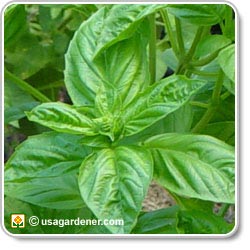 |
PLANT TYPE: Annual SCIENTIFIC NAME: Ocimum basilicum MATURE PLANT SIZE: 18 to 24 inches high x 12 inches wide LIGHT: Full Sun FLOWERING PERIOD: July to August SOIL TYPE: rich, moist, well-drained soil pH RANGE: 6.0 KNOWN PESTS: Japanese beetles KNOWN DISEASES: N/A |
OVERVIEW:
Basil is an attractive annual, about 18 inches tall with light-green, fairly broad leaves. The flowers are small, white, and appear in spikes. There are several species of cultivated basil, one having purple leaves.
Spicy-scented basil leaves are one of the most popular of all herbs used in cooking. Cooks favor basil for tomato dishes in either fresh or dried form.
Basil must have warm conditions, and prefers moist, rich, well-drained soil with pH of 6. Seedlings are slow-growing and delicate. Sow seed, 1/8 inch deep, in summer or indoors in late spring. When the seedlings appear, thin the plants to 1 foot apart. Susceptible to frost and cold. Water at mid-day not in the evening; avoid overwatering seedlings to prevent mildew. Basil is highly subject to heat and drought stress, and will “go to seed” practically overnight. Pinch off any developing seedheads regularly.
Basil originated in India, where it was regarded as a sacred herb. The name comes from the Greek basileus meaning
BASIL PROPAGATION / SOWING:
Seeds, cuttings, or transplants. Sow seed, 1/8 inch deep, in summer or indoors in late spring. When the seedlings appear, thin the plants to 1 foot apart.
COMPANION PLANTING:
Basil attracts butterflies and insects to the garden. It stimulates the growth of companion plants, especially tomatoes and peppers. It is said to repel white flies. Basil and rue do not do well when grown near each other.
CULTIVATING BASIL:
Basil must have warm conditions. For best results, sow in late spring or early summer. It is susceptible to cold and frost, and to drastic temperature change. Pinch the centers as the plants grow to ensure bushiness. Basil can be grown in pots but does not survive indoors.
HARVESTING BASIL:
Pick basil leaves every week, pinching terminal buds first to stimulate branching and encourage bushiness. Harvest should be in early autumn before the leaves turn limp and yellow. Cut stalks for drying before the plant comes into flower. Do not hang in bunches, as the leaves will dry too slowly and could mold.
USAGE:
Aromatic, cosmetic, culinary, and medicinal.Dried basil is used for its fragrance in potpourris and sachets. It also is used in herbal bath mixtures and to add luster to the hair. Fresh or dried basil is used in cooking to flavor Italian, Mediterranean, and Thai dishes. Fresh leaves are used in tomato and pesto sauces. Basil is good with veal, lamb, fish, poultry, white beans, pasta, rice, tomatoes, cheese, and eggs. It also is used in vinegar and for tea. Basil is said to have some medicinal qualities.